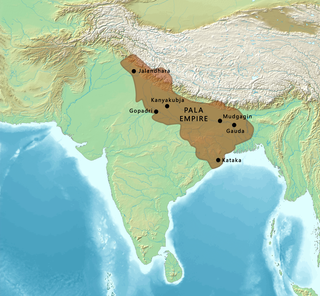
The Gurjara-Pratihara was a dynasty that ruled much of Northern India from the mid-8th to the 11th century. They ruled first at Ujjain and later at Kannauj.

The Pala Empire was an imperial power during the post-classical period in the Indian subcontinent, which originated in the region of Bengal. It is named after its ruling dynasty, whose rulers bore names ending with the suffix Pala. The empire was founded with the election of Gopala as the emperor of Gauda in late eighth century AD. The Pala stronghold was located in Bengal and eastern Bihar, which included the major cities of Gauda, Vikrampura, Pataliputra, Monghyr, Somapura, Ramvati (Varendra), Tamralipta and Jaggadala.

Mihira Bhoja or Bhoja I was a king belonging to the Gurjara-Pratihara Dynasty. He succeeded his father Ramabhadra. Bhoja was a devotee of Vishnu and adopted the title of Ādivarāha which is inscribed on some of his coins. One of the outstanding political figures of India in ninth century, he ranks with Dhruva Dharavarsha and Dharmapala as a great general and empire builder.

The Kamboja-Pala dynasty ruled parts of Bengal in the 10th to 11th centuries CE, after invading the Palas during the reign of Gopala II. The last Kamboja Kamboh ruler of the Kamboja-Pala Dynasty Dharmapala was defeated by the south Indian Emperor Rajendra Chola I of the Chola dynasty in the 11th century.

Bikrampur was a pargana situated 19 kilometres (12 mi) south of Dhaka, the modern capital city of Bangladesh. In the present day, it is known as Munshiganj District of Bangladesh. It is a historic region in Bengal and was a part of the Bhawal Estate.

Devapala (9th century) was the most powerful ruler of the Pala Empire of Bengal region in the Indian Subcontinent. He was the third king in the line, and had succeeded his father Dharamapala. Devapala expanded the frontiers of the empire by conquering the present-day Assam and Orissa. The Pala inscriptions also credit him with several other victories, but these claims are thought to be exaggerated.

Dharmapala (ruled between 770s-810s AD) was the second ruler of the Pala Empire of Bengal and Bihar regions in the Indian subcontinent. He was the son and successor of Gopala, the founder of the Pala Dynasty. He greatly expanded the boundaries of the empire, and made the Palas a dominant power in the northern and eastern India.
Rajyapala or Kamboja-Vamsa-Tilaka was the founder of the Kamboja Pala dynasty of Bengal. This dynasty had ruled over northern and western Bengal. Four rulers of this dynasty are known who ruled, either over north-west Bengal or parts thereof, from second half of tenth century to the first quarter of the 11th century. The last known king of Kamboja Pala dynasty was Dharmapala, who was the ruler in Dandabhukti division, during the first quarter of the 11th century.

Mahendrapala was the fourth king of the Pala dynasty of the Bengal region of the Indian subcontinent. He was the son of Devapala and his queen Mahata.

Vigrahapala was a 9th-century ruler of the Pala dynasty, in the Bengal region of the Indian subcontinent. He was the sixth Pala emperor. He reigned for a brief period before becoming an ascetic. Vigrahapala was a grandson of Dharmapala's younger brother Vakapala and son of Jayapala. He was succeeded by his son, Narayanapala.

Rajyapala was the eighth emperor of the Pala dynasty. He succeeded his father Narayanapala. He reigned for 32 years. The Bharat Kala Bhaban is dated in his 2nd regnal year, while the Bargaon inscription is dated in his 24th regnal year. He was succeeded by his son Gopala III.
Ramapala was the successor to the Pala king Shurapala II in the Bengal region of the Indian subcontinent, and fifteenth ruler of the Pala line.
Gopala IV, previously called Gopala III, was the successor and son to the Pala king Kumarapala in the Bengal region of the Indian subcontinent, and nineteenth ruler of the Pala line reigning for at least 15 years, proved by a manuscript currently at British library.
Madanapala was the successor to the Pala king Gopala IV in the Bengal region of the Indian subcontinent, and eighteenth and final ruler of Pala lineage reigning for 18 years. He was succeeded by Govindapala, whose lineage of that name is questionable.

The Tripartite Struggle also known as The Kannauj Triangle Wars for control of northern India took place in the ninth century, among the Pratihara Empire, the Pala Empire and the Rashtrakuta Empire.

Dharma Pala (1035–1060) was ruler of Pala Dynasty (900–1100) of Kamarupa Kingdom.

Shurapala I was a 9th-century ruler of the Pala Empire, in the Bengal region of the Indian subcontinent. He was the fifth Pala emperor. He ruled for at least 12 years.

Yashovarman, also known as Lakshavarman, was a king of the Chandela dynasty of India. He ruled in the Jejakabhukti region. He practically established the Chandelas as a sovereign power, although he formally acknowledged suzerainty of the Gurjara-Pratiharas. His major military achievement was the conquest of Kalanjara. He is also notable for having commissioned the Lakshmana Temple at Khajuraho.
Durlabha-rāja I was an Indian ruler belonging to the Chahamana dynasty. He ruled parts of present-day Rajasthan in north-western India as a vassal of the Gurjara-Pratihara king Vatsaraja.
Mahata Devi was the empress consort of Devapala, the greatest emperor of Pala dynasty. Her father was Durlabharaja I of Chahamana dynasty.










